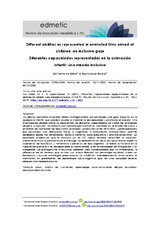Mostrar el registro sencillo del ítem
Different abilities as represented in animated films aimed at children: an inclusive gaze
| dc.contributor.author | del Moral, Mª Esther | |
| dc.contributor.author | López-Bouza, Nerea | |
| dc.date.accessioned | 2022-10-20T14:20:36Z | |
| dc.date.available | 2022-10-20T14:20:36Z | |
| dc.date.issued | 2021 | |
| dc.identifier.issn | 2254-0059 | |
| dc.identifier.uri | http://hdl.handle.net/10396/24153 | |
| dc.description.abstract | Los dibujos animados muestran relatos protagonizados por personajes con gran impacto en la audiencia infantil, que pueden ayudar a visibilizar la discapacidad y promover el respeto. Esta investigación analiza cómo se representan las diferentes capacidades en cortos de animación dirigidos a menores. Se adopta una metodología cualitativa, centrada en el estudio de casos y el análisis de contenido de diez cortos animados -producidos entre 2010-2020- y protagonizados por personajes con diferencias físicas o cognitivas. El instrumento Inclusive-Toons permitió analizarlos desde tres dimensiones: técnico-narrativa, socio-educativa y afectivo-emocional. Los resultados evidencian que la mayoría son en 3D, narran historias verosímiles sin locución, utilizando la música para enfatizar el mensaje. La representación de la discapacidad es explícita cuando es de tipo físico, y metafórica cuando es de tipo cognitivo. La trama se focaliza en la superación personal si la discapacidad es sobrevenida, o en la necesidad de integración si es congénita. Los protagonistas masculinos adoptan roles condicionados por sus limitaciones, a diferencia de las féminas que actúan con mayor libertad. Los personajes auxiliares suelen ser femeninos y buscan estrategias para resolver los conflictos. Indudablemente, estos relatos se convierten en plataformas de aprendizaje socio-cognitivo que, en una sociedad diversa, ofrecen una mirada inclusiva. | es_ES |
| dc.description.abstract | Cartoons show stories which starring characters have impact on children's audience, which can help to make disability visible and promote respect. The aim of this research is to analyze the representation of different abilities as shown in animation shorts aimed at children. The methodology used is qualitative and focused on the content study of ten short animated – between 2010-2020- which starring characters have physical or cognitive differences. The Inclusive-Toons instrument allowed analyzing them from three dimensions: technical-narrative, socio-educational and affective-emotional. The results show that most of them are in 3D, tell plausible stories without locution, using music to emphasize the message. The representation of disability is explicit when it is physical, and metaphorical when it is cognitive. The plot focuses on self-improvement if the disability is supervening, or on the need for integration if it is congenital. Male protagonists adopt roles conditioned by their limitations, while females who act more freely. Auxiliary characters are usually female and look for strategies to resolve conflicts. Undoubtedly, these stories become socio-cognitive learning platforms that, in a diverse society, offer the opportunity to develop an inclusive gaze. | es_ES |
| dc.format.mimetype | application/pdf | es_ES |
| dc.language.iso | spa | es_ES |
| dc.publisher | UCOPress | es_ES |
| dc.rights | https://creativecommons.org/licenses/by/3.0/ | es_ES |
| dc.source | Edmetic 10 (1), 20-39 (2021) | es_ES |
| dc.subject | Análisis de contenido | es_ES |
| dc.subject | Aprendizaje socio-emocional | es_ES |
| dc.subject | Dibujos animados | es_ES |
| dc.subject | Discapacidad | es_ES |
| dc.subject | Inclusión | es_ES |
| dc.subject | Cartoons | es_ES |
| dc.subject | Content analysis | es_ES |
| dc.subject | Disability | es_ES |
| dc.subject | Inclusion | es_ES |
| dc.subject | Social and emotional learning | es_ES |
| dc.title | Different abilities as represented in animated films aimed at children: an inclusive gaze | es_ES |
| dc.title.alternative | Diferentes capacidades representadas en la animación infantil: una mirada inclusiva | es_ES |
| dc.type | info:eu-repo/semantics/article | es_ES |
| dc.relation.publisherversion | http://www.uco.es/ucopress/ojs/index.php/edmetic/index | es_ES |
| dc.rights.accessRights | info:eu-repo/semantics/openAccess | es_ES |

